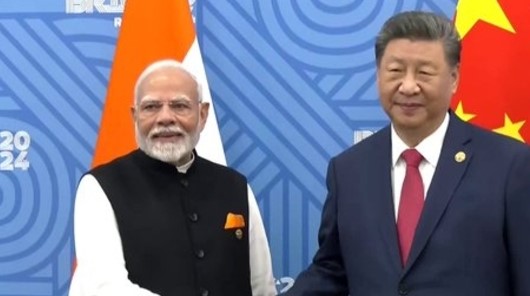In an era marked by increasing Chinese aggression, India’s cautious yet resolute approach to managing its border conflict with Beijing has served as a significant example for countries facing a similar challenge along its borders.
Recent developments, particularly the newly agreed upon arrangement concerning the patrolling of troops around Demchok and Depsang along the Line of Actual Control (LAC), is a noteworthy example of how India is effectively balancing firmness with diplomacy while engaging with Beijing; a method that can potentially serve as a template for countries facing China’s assertive behaviour.
The announcement of the recent border arrangement just before the BRICS Summit in Kazan, Russia, led to a formal bilateral meeting between Indian Prime Minster Narendra Modi and Chinese President Xi Jinping for the first time in almost five years.
This development, came in light of the Chinese side agreeing to withdrawing from transgressed region on Indian territory and restoring the status quo along the LAC back to its position before April 2020.
By retaining patrolling rights in sensitive areas like Demchok and Depsang, India has demonstrated that it would not implicitly accept an altered status quo and was willing to freeze bilateral relations until an agreement on the same was reached.
This was a signal to both Beijing as well as the global community that while it seeks stability, it will not compromise on its territorial sovereignty.
Furthermore, this also underscores the variety of options New Delhi can potentially employs, in its pursuit of not only settling bilateral disputes but also projecting its global ambitions.
At the BRICS Summit, India had the unique opportunity to portray itself as a responsible power, that sought peace and stability along with development through a common approach.
By leading through example, both in settling its own dispute as well as advocating for the development of the developing world, New Delhi showcased to the world that it did not seek aggression, but mutual cooperation as the way forward for its model of leadership.
This was not only in sharp contrast to Beijing’s leadership approach, but was also an opportunity to subtly unveil China’s regressive policies of incursions across its borders.
A diplomatic win of this sorts, has therefore been marked by a blend of pragmatism and restraint from New Delhi’s perspective.
Rather than resorting to aggressive posturing or escalating military tensions, New Delhi engaged in diplomatic discussions aimed at de-escalating conflicts through various diplomatic channels including high level ranking official meetings.
This method not only enhanced New Delhi’s credibility but also underscored a broader commitment to leading through peaceful means instead of force.
On the contrary, Beijing evidently chosen to escalate frictions through militarily transgressing and thereby deeming all previous bilateral agreements as null and void.
By choosing dialogue over confrontation, unlike China, India effectively showcased how measured responses can lead to constructive outcomes.
India’s Template for the World?
To state that the implications of this approach would extend beyond the India-China border, would not be an overstatement.
Other countries, especially those in the Indo-Pacific as well as in Southeast Asia, can draw valuable lessons from India’s strategy of taming China’s aggressive posturing.
In an environment where China’s assertiveness often leads to anxiety among its neighbours, the latest development along the India-China border has demonstrated that maintaining a firm stance while engaging diplomatically can help mitigate as well as resolve longstanding tensions with Beijing.
Moreover, India’s recent development also highlights the importance of a consistent front.
By regularly linking the deteriorating the state of relations with that of the crisis along the border, India maintained a singular tone of concern, avoiding granting Beijing the opportunity to divert away from New Delhi’s aspersions of infringement of territorial sovereignty.
Thus, under such circumstances, India’s cautious approach to its border conflict with China offers a constructive blueprint for other countries that are grappling with similar challenges.
By retaining key strategic advantages while embracing dialogue, India has set an example of how to engage with an aggressive neighbour effectively.
As the international community looks to handle the complexities of China’s growing aggressive posturing, India’s model of combining firmness with diplomacy should very well serve as a guiding principle for taming China’s assertive strategies, enabling a more stable and cooperative regional order.









Comment